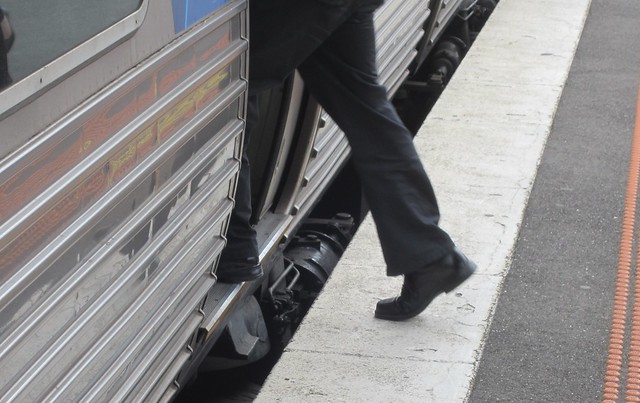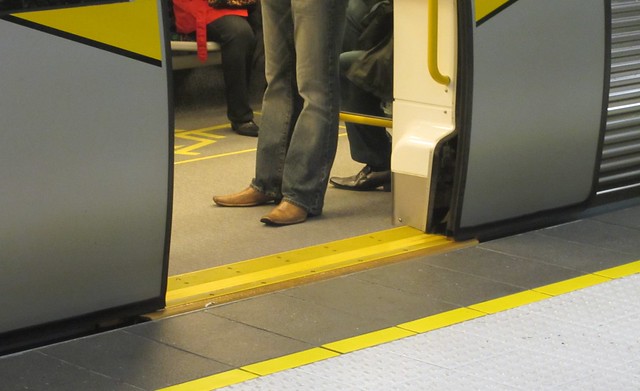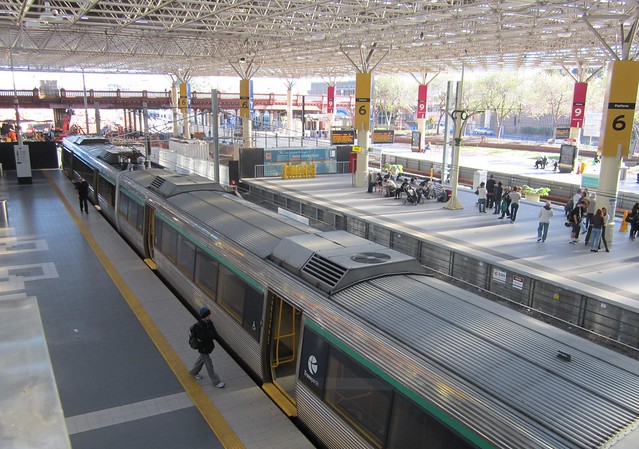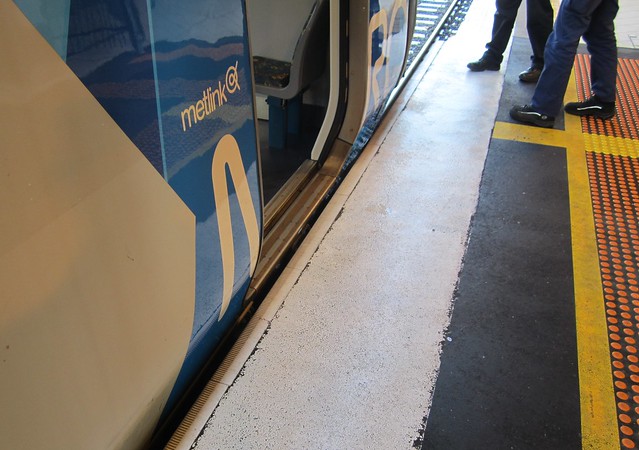On Sunday Channel 7 showed this CCTV footage shot at Southern Cross station. A toddler slipped between the train and the platform.
I found it quite difficult to watch, but there’s an obvious safety message here which was emphasised in Monday’s followup story: you do need to take the utmost care when boarding and alighting trains, especially where small children are involved.
It’s also important to push prams onto trains, but pull them backwards off when alighting, so you can see that the wheels have made it across the gap.
Mind the gap
Fact is, in Melbourne and many cities, there are some significant gaps between trains and platforms — particularly at curved platforms.
But here’s something I found fascinating: in Perth, there’s virtually no gap.
I’m not sure how they’ve managed it, nor if it applies to every station, but every train I saw was dead level with the platform, and with only a few centimetres of gap. In fact I tried stepping deliberately half on the train and half on the platform with my shoe at one station — no problems.
How do they do it? (The bits sticking out from the trains are in a fixed position.)
I suppose it comes down to much more rigid design and engineering standards, a smaller (and in many parts significantly newer) network, and less variations in the fleet.
One benefit is that it seems wheelchairs are self-loaded — as can be seen on page 22 of this brochure, they don’t need to get the driver to deploy a ramp, which speeds things up.
Melbourne are trying this with modifications to some platforms — this one is at Flinders Street platform 1.






8 replies on “Mind the gap! (except in Perth where they seem to have no gap)”
Box Hill was the first railway station in Melbourne to trial level access for wheelchairs – I believe it was installed in early 2011:
http://www.candoability.com.au/CDA/Blog/Independently-Accessible-Trains_159.html
Newport has received one since:
http://www.metrotrains.com.au/news/2012/aug/30/new-accessibility-ramp-newport
As for the rest of the network, it seems that no one in charge cares about being consistent about platform heights – even brand new stations don’t have level boarding, and older stations vary in height between doors!
As a wheelchair user who uses trains on a daily basis I would like to see more fixed ramps. At some stations, such as Richmond platform 9/10 it is hard to get up the non fixed ramp due to the steep gradient. I have used the fixed ramps at Box Hill and Flanders Street platform one and found them to be quite convenient. One issue that I have seen is that some disabled people are unable to interdependently open the doors on the older trains where you have to pull the handle rather then push a button, so the driver still needs to get out and help.
apart from getting platform height correct, I’d imagine that this would only work on straight platforms – any curve would produce a gap unless you can ensure that doorways are immediately over bogeys and therefore always a fixed distance from the platform edge … can’t quite tell that from your images of the Perth fleet there
There are still some platform gaps in Perth, almost all of them on the older lines. Currently there is a rolling programme to upgrade the stations, also I believe there has been minor track realignment when resleepering with concrete sleepers. Sherwood station on the Armadale Line has (or at least had – don’t know if it still does) an automatic announcement for “please mind the gap”, at least for the 5 people that use it…
Also note the rubber-ish extension to the Perth trains next to the doorway to bridge the gap, I believe by design on the B series (new ones) and retrofitted to the older type.
Not entirely sure how curves are dealt with, I don’t think the doors are right above the bogies but even then the gap is still fairly tiny.
Ramp services are available in Perth I believe, but handled by customer service rather than the train staff. Especially at unattended stations (no doubt just about all of the inaccessible platforms!), this means phoning ahead by at least one hour.
(A “fully accessible” platform gap in Perth is 15mm Vertical and 40mm horizontal.)
So how does that work then ? You call them, and a station attendant goes there from another station to help you ?
Do they drive there, or catch the train ?
Windsor station has a curving platform that also varies in height along the train on the Sandringham bound side/north platform. (I don’t remember which platform it is,1 or 2.) If one is stepping out of the carrage located in the middle of the train there is quite a bit of a step down to the platform that is surprising if you are not paying attention when exiting. Closer to the front of the train the platform is much more level with the train’s floor. I’m not sure if the Comeng and Seimens trains which both run on this line have the same floor height. I think the station is from the 1880’s and the platform must have had many train designs pass it over the years.
Did you use the trains in Brisbane much, Daniel? Virtually every station has platforms noticeably lower than the train, even the city stations – the only ones that don’t are the new/upgraded stations on the Airport – Beenleigh/Gold Coast corridor.
The worst ones can be as bad as this: http://resources2.news.com.au/images/2009/09/15/1225773/505914-rail-platform-curve-a-real-danger.jpg
I found it odd in Perth a few years back to watch a wheelchair passenger on the Armadale line drive himself onto the train, then drive himself off again a few stops later with no need for a ramp or any intervention from the driver!
They are on every Transperth train and the messages occur at every station, particularly for “The next train does not stop at this station”.